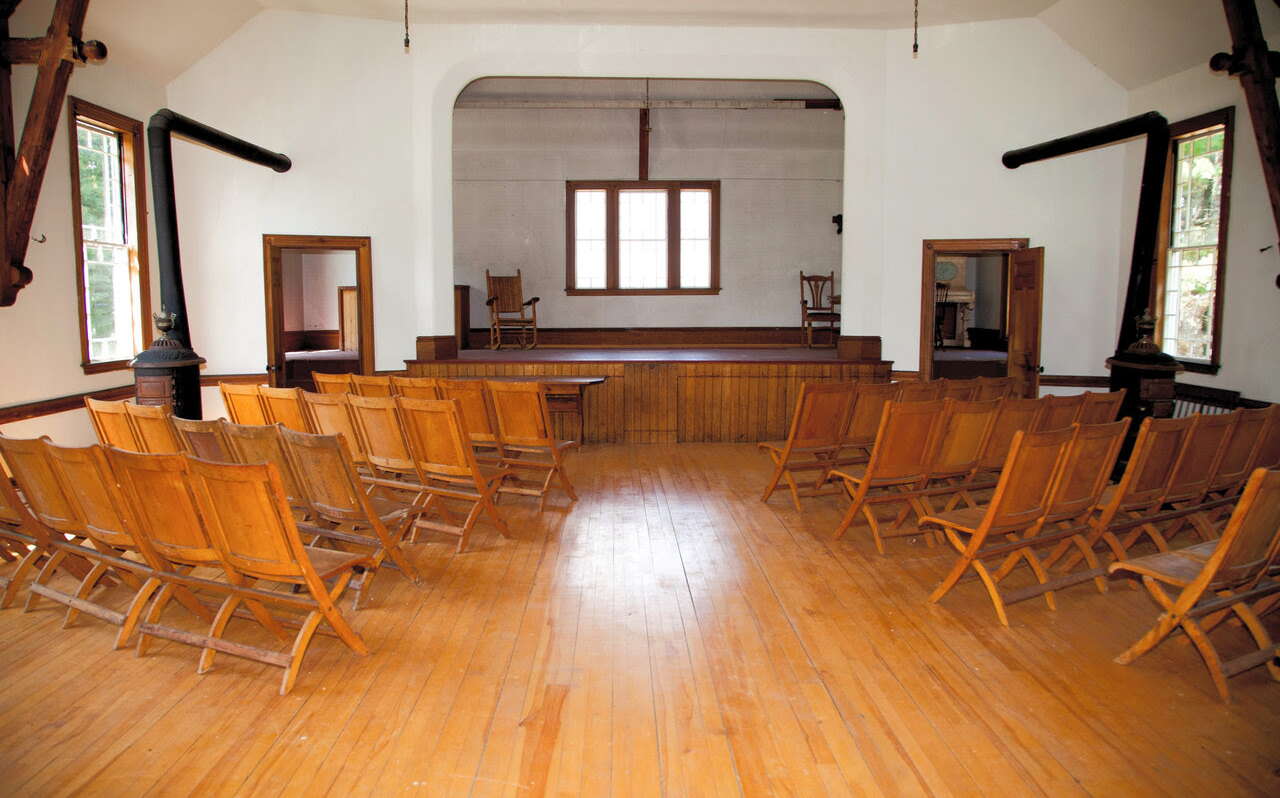
After ‘losing its way,’ Bridgton’s historic community hall has extensive rehab underway
 Photo / Courtesy, Walker Memorial Hall Corp.
Walker Memorial Hall, dating back to 1892, is undergoing extensive rehabilitation.
Photo / Courtesy, Walker Memorial Hall Corp.
Walker Memorial Hall, dating back to 1892, is undergoing extensive rehabilitation.
A historic community meeting hall at 421 Highland Road in the Cumberland County town of Bridgton is undergoing an extensive rehabilitation after a period of neglect.
Walker Memorial Hall is an example of Queen Anne architecture built in 1892. The structure includes a three-story tower with a belfry and gables and a portico.
“The hall was built by Joseph Walker, who requested that the building be used to achieve the greatest good for the greatest number of residents of the district,” said Ken Abbott, president of the Walker Memorial Hall Corp., which is leading a group of community volunteers in the restoration and renovation effort.
“Five years ago, the hall was languishing and largely unused,” said Abbott. “A group of neighbors formed this nonprofit to rehabilitate this historic site and make it a vital support for the surrounding community once again.”
Extensive project
The effort included forming a 501(c)3 nonprofit corporation to enable tax-free donations and transferring ownership of the property from a trust to the nonprofit corporation, Abbott told Mainebiz.
Renovations, both completed and for the future, include:
- New roof; repair or remove rotted gutters and fascia boards
- Rehabilitate foundation
- Regrade around building; add a parking lot; remove brush and trim trees
- Install new electric service; upgrade old knob-and-tube wiring; install electrical outlets (the building originally had only one outlet on the first floor and one on the second); replace all light fixtures
- Install new water well; install septic system (originally the lot was too small to allow both well and septic. Land donated from an adjacent lot owned by a neighborhood association made it possible)
- Make building compliant with the Americans With Disabilities Act; add accessible ramp; replace existing privy that consisted of three pit toilets with new ADA-compliant bathroom; install audio/visual equipment instead of having to make second floor accessible
- Repaint interior walls, floor and ceilings; patch and repair plaster walls and ceilings; rehabilitate woodwork and windows
- Install modern kitchen
- Inventory and curate the library, two mineral collections and a cabinet of curiosities
- Dispose of accumulated trash, broken furniture, two of three antique pianos and dead appliances.
Bequest for the community
Walker Memorial Hall, also known as Ridge Hall, was built for the benefit of residents of Bridgton School District 18 by a bequest from Joseph Walker, a Maine businessman and summertime resident of Bridgton, according to the corporation.

It has been maintained for 130 years by trustees and funded by grants and voluntary contributions from the community.
The nonprofit Walker Memorial Hall Corp. was created in 2021 to renovate the building. The corporation was founded and staffed by volunteers from the nearby community who contribute time and money to the restoration project. The corporation owns and manages Walker Memorial Hall.
The hall was designed by Frederick Tompson of Portland, a Maine architect. The building was erected in the summer of 1892 in accordance with a $5,000 bequest in Joseph Walker’s will. Walker requested that the building be used as a library, for lectures, for the promotion of agriculture or to achieve the greatest good for the greatest number of residents of the district.
Upon completion, the hall had a cupola; a library, kitchen and dining room downstairs; and an auditorium and stage upstairs.
First used by the Ridge Literary Society, the hall served local farm families. Over the years, gatherings and community functions took place there, such as Sunday services, dances, plays, holiday parties and circle suppers.
The building was added to the National Registry of Historic Places in 1983.
‘Lost its way’
By the end of the 20th century, the hall "lost its way” due to changing times, lack of modern amenities and changes to the nature and needs of the surrounding community, the corporation said.
Coming into the 21st century, the hall languished, was minimally maintained and largely unused.
In 2021, a group of nearby neighbors formed a nonprofit corporation dedicated to rehabilitating the historic site and making it once again a support for the surrounding community.
The overarching goal is to renovate the structure to meet modern expectations and standards, while maintaining the historic feel and connection to the past of the structure.
Historical awareness
Abbott said that an unexpected and somewhat tricky aspect of the project was tracing back the history of the hall to determine ownership and potential restrictions on trustees. A trust was created by the probate court in 1891 but essentially had no deed other than one transferring the property to one of Walker’s estate attorneys in 1892. There was no trust document other than Walker’s will, so “it took considerable detective work to discover who actually owned the property,” said Abbott.
He continued, “I think everyone involved liked the historical ‘awareness’ that was forced on us by the project. Figuring out what the hall was required digging into history, through documents, books and anecdotes from local people who remembered the hall from their childhood.”
For example, there are a number of old articles in the Bridgton News about doings at the hall in the early 1900s. A person in the family that has run the Bridgton News found and donated a preprint of a nearly full-page article from November 1891 about the newly built hall.
“There was a sketch of the exterior of the building, and detailed descriptions of the interior, including paint colors and finishes,” said Abbott.
Tipping point
There came a tipping point when it became apparent some work needed to be done.
“In 2019, one of the trustees discovered that a section of the roof had failed, and there was water damage inside the building,” said Abbott. “As had been the practice for decades, the trustees solicited donations from the local community to pay for a reroofing project.”
A group of neighbors realized that, without regular care and maintenance, the building would continue to deteriorate and become a neighborhood liability; and that, even with care and maintenance, the building was outmoded and not useful, he said.
“The group of neighbors realized that the choices were basically to either raze the useless structure, or to double down by investing to renovate the building to make it useful and viable,” he continued. “This core group doubled down and started the project in earnest in 2021.”
It’s expected that the building will be functional — with water, septic, bathroom, electrical and lighting in place and other project components completed — by the fourth quarter of 2025, with the
The total cost is estimated to be between $200,000 and $225,000. So far, financing has been primarily by private donations and some corporate donations.
In 2024, the corporation started applying for grants. That includes a recent $10,000 commitment from Norway Savings Bank.
“This is an effort that is not only preserving this historic building, but is also enabling and encouraging modern-day use,” said Dan Walsh, the bank’s president and CEO. “It’s wonderful that a new generation will have the opportunity to add their own chapter to a story that began over 130 years ago.”
It’s expected that, over time, funding will increasingly come from usage fees and grants.
Events venue
Throughout its history, the hall has been used for community events such as bean suppers, dances, theatrical performances, musical performances, ice cream socials, and corporate and charitable events.
“We expect these types of activities to gradually resume once the hall is back in shape, but we also intend to promote the hall as venue for events hosted by other nonprofits in the area,” said Abbott. “The Bridgton area has dozens of nonprofits and a shortage of affordable, quality space for hosting events.”
Abbott said the corporation welcomes use of the hall during renovation.
“Prior to renovation, usage had fallen close to zero, so part of our challenge is to spread the word that the hall is available,” he said. “Until we have working plumbing, users have to be willing to do without or rent facilities. We recently received a donation of a working parlor grand piano, which will spark interest in musical performances.”
The hall has an important place in the community, he added.
“The hall is an important connection to the past for people today — a connection that is disappearing,” Abbott said. “People enjoy being in contact with an authentic commemoration of the past. This can act as a focal point for the reinforcing the identity and shared history of the community.”










0 Comments